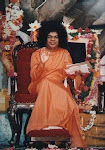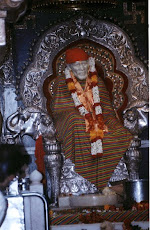Puttaparthi in the early 40's consisted of only two lanes, which met each other at right angles in addition to a few mud huts. A western author, Arnold Schulman, who visited this hamlet in late sixties described this cluster of scattered huts as "ten minutes past the Stone Age". Bhagavan Baba has transformed this so-called Stone Age village into a modern township with a unique educational complex and a university, a super speciality hospital with all modern facilities and an airport of its own. The crest jewel of this now world-known place is Prashanthi Nilayam, where millions come every year from all corners of the world to receive the blessings of the Avatar.
The number of devotees kept on increasing with the result that in a few years the Old Mandir could not accomodate them. Even sheds and makeshift Pandals around the Old Mandir were inadequate during festivals. In answer to the prayers of the devotees, Baba agreed for a more spacious place. Thus, the idea of New Mandir was conceived and the same was constructed at a place to the south of the village of Puttaparthi. Bhagavan Baba inaugurated it on 23rd November 1950 on his 25th birthday and named it Prashanthi Nilayam (the abode of supreme peace).
Prashanthi Nilayam, the abode of Bhagavan Baba, bears testimony of Bhagavan's Divinity. The millions who throng this small township in a remote part of Andhra Pradesh in India experience its divine vibrations, which are soaked in its atmosphere. They come from all parts of the world, from nearly 180 countries spending their money and time to have Darshan and blessings of Bhagavan. When they return to their countries and places, they carry with them numerous stories of experiences, which describe the divine love of Bhagavan for the entire mankind. Bhagavan's presence has made Prashanthi Nilayam a township of love and peace. It is a different world altogether where Sathya, Dharma, Santhi, Prema and Ahimsa permeate the entire environment. Though there are crowds evwerywhere, there are no jarring noises. There is cleanliness, order, discipline, courtesy and humility everywhere. This is a mini world in itself. People from different countries following different religions, speaking different languages live together, dine together and mingle with each other with sacred feelings of love and brotherhood. If one wants to see "brotherhood of man and fatherhood of God" not merely in theory but in practice, one can see it in Prashanthi Nilayam.
Saturday, September 20, 2008
Monday, September 8, 2008
Wel Come To India and Culture
India Culture
India is the heart of wonderful culture of the whole world. Since time immemorial, India harbors a world in itself. It.s diversity in language; religion, art, architecture, music and cuisine give it an ancient aura and make it most majestic, historic and forever alluring to the whole mankind. Indian art has flourished since Indus Valley Civilization period, about 2500 BC. The magnificent sites of this ancient civilization can be witnessed at Lothal and Kalibangan. Mostly there were religious and symbolic representations unique to India then but with the advent of Alexander the Great and even after, art started flourishing with Greek style carvings and sculptures. Indigenous Indian art and culture has been immensely influenced by the foreign invasions throughout the ages and totally new form of art evolved unique to India only. During 500 AD the famous Ajanta and Ellora caves were carved under the golden age of the Guptas. Today, almost all states in India are the epitome of wonderful art and architecture.
Northern India boasts of the exquisite style of Mughal art and architecture. Delhi was the Mughal nerve center and the onlooker of the grand Jama Masjid (India.s major mosque), Qutab Minar (rated as one of the tallest cylindrical buildings of the world), and the Red Fort. The grandest of all mausoleums and one of the seven wonders of the modern world, the Taj Mahal in Agra not only epitomizes the love of an emperor for his wife but is also a delicate work of art of stunning proportions. Western India proposes a totally different style of art; the Rajput art and architecture can be observed in all their grandeur in the forts, palaces, temples, caves and even water wells of Gujarat and Rajasthan. Southern India displays a totally unique style of art in their temple drawings and temple architecture. Eastern India with its vibrant tribal art and culture and influences of Buddhism conveys some outstanding art forms in the Buddhist Thangkas (paintings of the life and enlightenment of Buddha) and the monasteries. The temples all over display excellent skill of carvings and impressive sculptures. There is uncountable number of temples and stupas and buildings, which provide an exhilarating, sight. There are also lavish paintings and books that throng the canvas of India.
India is also famous in its number of dance forms and music. The dance forms include Classical to Symbolic to Western. Bharatnatyam, Kathakali, Natya Mela, Yakshagna, Mohini Attam and Kuchipudi are mainly popular in south. Even enacting the Shiva and Durga dances and Krishna episodes are very popular throughout India. Odissi is closely linked to Jainism, Buddhism and Hinduism. Kathak, the court dance of the Mughals is a blend of Persian dance forms with Indian classical. Manipuri from North Eastern India is also a exclusive classical form of dance enacting the extracts of the epics of Ramayana and Mahabharata.
India also has a range of cuisines. The South Indians have rice and grind their spices to paste and cook with it, making heavy use of coconut milk, while North Indians rely more on wheat and other grains.
Each of the dishes like the Bengali food, the Punjabi, the Gujarati, the Rajasthani, the South Indians have their own tastes and cuisines. Dairy products like milk, sour cream, yogurt, cream, buttermilk and cheese are largely used all throughout the country. Even dried fruits like cashews, almonds and pistachios and spices like saffron, cinnamon, cloves and cardamom give a finishing touch to every Indian dish. Fish cooked in various sweets and sours, meat dishes pork and ducks cooked in vinegar and spices comprises major Indian cuisines. India has its pride in sweets, Bengal especially boasts of a special soft sweet called .Rasgullas..
The festivals also show the rich cultural heritage of India. Bengal celebrates Durga Pujo and Diwali with great flair. Even the flamboyant Holi, the Dushera, Pongal, Onam, Id-ul-zoha, Muharram and Christmas are celebrated with great happiness. People exchange gifts and greetings with families and friends, all over the world.
India is the heart of wonderful culture of the whole world. Since time immemorial, India harbors a world in itself. It.s diversity in language; religion, art, architecture, music and cuisine give it an ancient aura and make it most majestic, historic and forever alluring to the whole mankind. Indian art has flourished since Indus Valley Civilization period, about 2500 BC. The magnificent sites of this ancient civilization can be witnessed at Lothal and Kalibangan. Mostly there were religious and symbolic representations unique to India then but with the advent of Alexander the Great and even after, art started flourishing with Greek style carvings and sculptures. Indigenous Indian art and culture has been immensely influenced by the foreign invasions throughout the ages and totally new form of art evolved unique to India only. During 500 AD the famous Ajanta and Ellora caves were carved under the golden age of the Guptas. Today, almost all states in India are the epitome of wonderful art and architecture.
Northern India boasts of the exquisite style of Mughal art and architecture. Delhi was the Mughal nerve center and the onlooker of the grand Jama Masjid (India.s major mosque), Qutab Minar (rated as one of the tallest cylindrical buildings of the world), and the Red Fort. The grandest of all mausoleums and one of the seven wonders of the modern world, the Taj Mahal in Agra not only epitomizes the love of an emperor for his wife but is also a delicate work of art of stunning proportions. Western India proposes a totally different style of art; the Rajput art and architecture can be observed in all their grandeur in the forts, palaces, temples, caves and even water wells of Gujarat and Rajasthan. Southern India displays a totally unique style of art in their temple drawings and temple architecture. Eastern India with its vibrant tribal art and culture and influences of Buddhism conveys some outstanding art forms in the Buddhist Thangkas (paintings of the life and enlightenment of Buddha) and the monasteries. The temples all over display excellent skill of carvings and impressive sculptures. There is uncountable number of temples and stupas and buildings, which provide an exhilarating, sight. There are also lavish paintings and books that throng the canvas of India.
India is also famous in its number of dance forms and music. The dance forms include Classical to Symbolic to Western. Bharatnatyam, Kathakali, Natya Mela, Yakshagna, Mohini Attam and Kuchipudi are mainly popular in south. Even enacting the Shiva and Durga dances and Krishna episodes are very popular throughout India. Odissi is closely linked to Jainism, Buddhism and Hinduism. Kathak, the court dance of the Mughals is a blend of Persian dance forms with Indian classical. Manipuri from North Eastern India is also a exclusive classical form of dance enacting the extracts of the epics of Ramayana and Mahabharata.
India also has a range of cuisines. The South Indians have rice and grind their spices to paste and cook with it, making heavy use of coconut milk, while North Indians rely more on wheat and other grains.
Each of the dishes like the Bengali food, the Punjabi, the Gujarati, the Rajasthani, the South Indians have their own tastes and cuisines. Dairy products like milk, sour cream, yogurt, cream, buttermilk and cheese are largely used all throughout the country. Even dried fruits like cashews, almonds and pistachios and spices like saffron, cinnamon, cloves and cardamom give a finishing touch to every Indian dish. Fish cooked in various sweets and sours, meat dishes pork and ducks cooked in vinegar and spices comprises major Indian cuisines. India has its pride in sweets, Bengal especially boasts of a special soft sweet called .Rasgullas..
The festivals also show the rich cultural heritage of India. Bengal celebrates Durga Pujo and Diwali with great flair. Even the flamboyant Holi, the Dushera, Pongal, Onam, Id-ul-zoha, Muharram and Christmas are celebrated with great happiness. People exchange gifts and greetings with families and friends, all over the world.
Subscribe to:
Posts (Atom)
Well Come To Puttaparthi

sri sathya sai baba



